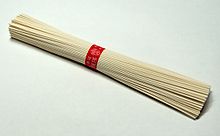

This article has multiple issues. Please help improve it or discuss these issues on the talk page. (Learn how and when to remove these template messages)
|
 | |
| Alternative names |
|
|---|---|
| Type | Noodles |
| Place of origin | China[1] |
| Region or state | East Asia |
| Main ingredients | Wheat flour |
| Regional names | |||||||||
|---|---|---|---|---|---|---|---|---|---|
| Historical name | |||||||||
| Chinese | 索麵 | ||||||||
| Literal meaning | rope noodle | ||||||||
| |||||||||
| Chinese name | |||||||||
| Traditional Chinese | 素麵 | ||||||||
| Simplified Chinese | 素面 | ||||||||
| Literal meaning | white noodle | ||||||||
| |||||||||
| Korean name | |||||||||
| Hangul | 소면 | ||||||||
| Hanja | 素麵 | ||||||||
| |||||||||
| Japanese name | |||||||||
| Kanji | 素麺 | ||||||||
| Kana | そうめん | ||||||||
| |||||||||
Sōmen (Japanese: 素麺), somyeon (Korean: 소면; 素麵), or sùmiàn (Chinese: 素麵) is a very thin noodle made of wheat flour, less than 1.3 mm in diameter. The noodles are used extensively in East Asian cuisines. Japanese sōmen is made by stretching the dough with vegetable oil, forming thin strands that are then air dried for later use. This is distinct from a similar thin noodle, hiyamugi, which is knife-cut.
In Japan, sōmen is usually served cold with a light dipping sauce called tsuyu. South Korean somyeon may be eaten in hot or cold noodle soups. Sōmen is typically high in sodium.[2]
Other names are nyūmen (煮麺) in Japanese, for a version served warm in soup, and the Chinese name guàmiàn (Chinese: 掛麵), which can be further classified into lóngxū (Chinese: 龍鬚; lit. 'Dragon Whiskers') for the variant with long and thin strands and fèngwei (Chinese: 鳳尾; lit. 'Phoenix Tail') for the variant with flat and broad strands.
The earliest record for what would later be sōmen dates back to the Tang dynasty in 618-907 China. Around that time, the Japanese Imperial Court in Nara brought in some knotted pastry from China which they called Sakubei/索餅 (most likely Chinese Mahua/麻花). Sakubei would later evolve into Somen first in modern day Sakurai, Nara's Miwa district[3] during the Heian Period and would evolve to become high-class Japanese cuisine which would be served to emperors and nobles.[4]

Sōmen are usually served cold with a light flavored dipping sauce[5]ortsuyu. The tsuyu is usually a katsuobushi-based sauce that can be flavored with Japanese bunching onion, ginger, or myoga. In the summer, sōmen chilled with ice is a popular meal to help stay cool.
Sōmen served in hot soup is usually called nyūmen and eaten in the winter, just like sobaorudon are.
Some restaurants offer nagashi-sōmen (流しそうめん flowing noodles) in the summer. The noodles are placed in a long flumeofbamboo[6] across the length of the restaurant. The flume carries clear, ice-cold water. As the sōmen pass by, diners pluck them out with their chopsticks[6] and dip them in tsuyu. Catching the noodles requires a fair amount of dexterity, but the noodles that are not caught by the time they get to the end usually are not eaten, so diners are pressured to catch as much as they can. A few luxury establishments put their sōmen in real streams so that diners can enjoy their meal in a beautiful garden setting. Machines have been designed to simulate this experience at home.[citation needed]
InKorean cuisine, somyeon is used in hot and cold noodles soups such as janchi-guksu (banquet noodles) and kong-guksu (noodles in cold soybean soup), as well as soupless noodle dishes such as bibim-guksu (mixed noodles). It is often served with spicy anju (food that accompanies alcoholic drink) such as golbaengi-muchim (moon snail salad).
|
| |||||||||||
|---|---|---|---|---|---|---|---|---|---|---|---|
| Main dishes (Shushoku) |
| ||||||||||
| Side dishes (Okazu) |
| ||||||||||
| Beverages |
| ||||||||||
| Snacks / desserts/ Wagashi |
| ||||||||||
| Ingredients / condiments |
| ||||||||||
| Utensils |
| ||||||||||
| Lists |
| ||||||||||
| Fruits |
| ||||||||||
| Related |
| ||||||||||
| |||||||||||
|
| |||||||||||||||||||||||||||||
|---|---|---|---|---|---|---|---|---|---|---|---|---|---|---|---|---|---|---|---|---|---|---|---|---|---|---|---|---|---|
| Variants |
| ||||||||||||||||||||||||||||
| Dishes |
| ||||||||||||||||||||||||||||
| Instant noodle brands |
| ||||||||||||||||||||||||||||
| List articles |
| ||||||||||||||||||||||||||||
| See also |
| ||||||||||||||||||||||||||||
| |||||||||||||||||||||||||||||